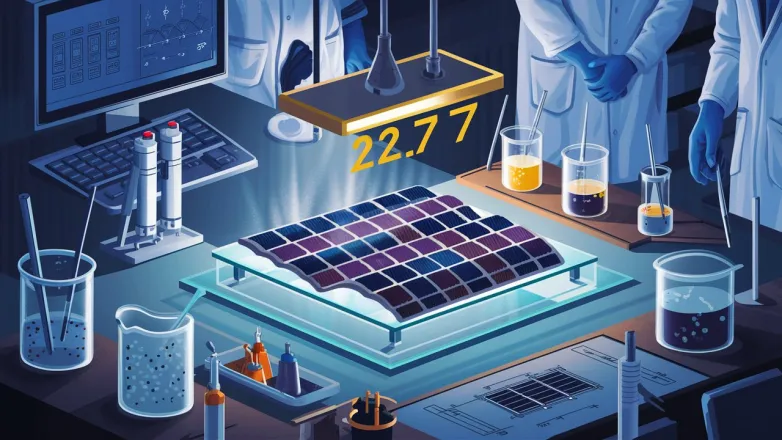Cadmium-Doped Perovskite Solar Cell Achieves 22.7% Efficiency
- Breakthrough in solar cell technology: Researchers achieve 22.7% efficiency with cadmium-doped perovskite cells, overcoming stability challenges for a brighter, more sustainable future.

Researchers from the University of Victoria, University of British Columbia, and Henan University have developed a cadmium-doped perovskite solar cell with an efficiency of 22.7%. By using cadmium iodide doping, the team stabilized the blade coating process in the manufacturing of solar cells based on formamidinium lead iodide (FAPbI3) perovskite, resulting in a significant increase in efficiency compared to cells without cadmium doping. FAPbI3 is a promising material for solar cells due to its narrow energy bandgap and stability, but challenges remain due to polymorphism and fabrication sensitivity.
The introduction of cadmium iodide was found to stabilize the blade coating process at room temperature, reducing the polymorphism issue and improving the performance of the solar cells. The team used compositionally graded film optimization to deposit different concentrations of CdI2 in the FAPbI3 film, leading to enhanced photoluminescence and improved film stability. The cell design included a glass/ITO substrate, a cadmium-doped FAPbI3 absorber, and achieved an efficiency of 22.7% under standard illumination conditions.
The researchers also observed reduced charge trapping and longer lifetimes in the cadmium-doped sample, leading to increased charge accumulation and higher open-circuit voltage. Solar cells with cadmium doping showed improved reproducibility and efficiency compared to cells without doping, demonstrating the potential of cadmium-doped perovskite solar cells for future applications.
How did researchers improve efficiency of perovskite solar cells using cadmium doping?
- Cadmium iodide doping stabilized the blade coating process in the manufacturing of solar cells based on FAPbI3 perovskite, leading to a significant increase in efficiency.
- Compositionally graded film optimization was used to deposit different concentrations of CdI2 in the FAPbI3 film, resulting in enhanced photoluminescence and improved film stability.
- The cadmium-doped perovskite solar cell design included a glass/ITO substrate and achieved an efficiency of 22.7% under standard illumination conditions.
- The introduction of cadmium iodide reduced charge trapping and increased charge accumulation, leading to higher open-circuit voltage and longer lifetimes in the solar cells.
- Solar cells with cadmium doping demonstrated improved reproducibility and efficiency compared to cells without doping, showing the potential of cadmium-doped perovskite solar cells for future applications.
Also read
- Camphor Additives Boost Perovskite Solar Cell Efficiency
- NUS Sets Record With 26.4% Perovskite-Organic Solar Cell
- Boric-acid interface pushes all-perovskite tandem cell efficiency to 28.5 %
- World-Leading Efficiency: NUS Team Sets World Record with 26.4% Perovskite-Organic Tandem Cell
- Trina’s 841-W Tandem Panel Shakes Up SNEC 2025
